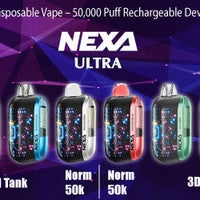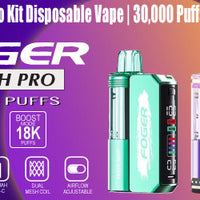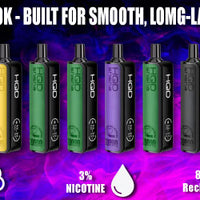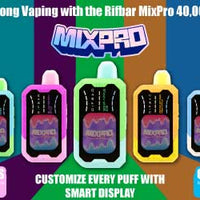What are the differences between vape pens & portable vaporizers, there’s been some confusion over the difference between a vape pen and portable vaporizer. Initially, the differences between vape pens and portable vaporizers might seem subtle, but each device type provides a unique experience. All vape pens are portable vaporizers, but not all portable vaporizers are vape pens. But they’re alike enough in their handheld nature that people can’t always tell them apart.
It's a Portable Vaporizer if It is handheld. Portable vaporizers are compact (though usually not as compact as vape pens). Portable vapes take many different shapes, from the sleek rectangular build. One type of vaporizer is usually more discreet, while the other has more features and better vapor production.
It’s a Vape Pen if It is pen-shaped more like an office pen, but usually thicker because it has batteries inside. Vape pens are designed to be concealed. They hide in your hand, slip into your pocket, and when spotted, look similar enough to an e-cigarette. In other words, a vape pen is generally more portable and discreet than a portable vaporizer.
Now of course some portable vaporizers are exceptionally discreet. But There’s more to distinguish between a vape pen and portable vaporizer than just by its design. Vape pens are more slender, and therefore a little more discreet and portable, than most portable vaporizers. But that difference in build also reflects in their performance, usability, and more. Heating Systems Because vape pens are slender, their heating systems are in most cases not as advanced as those found in portable vaporizers. Most vape pens have conduction heating systems, which means material is heated directly on the surface of the heating element known as the atomizer.
Conduction vaporizers therefore deliver slightly less smooth, smoky tasting vapor. Portable vaporizers can feature either conduction or convection heating systems. Convection vaporizers deliver very pure vapor that is smoother and more flavorful because there’s no combustion. By blowing hot air through the heating chamber rather than cooking it directly on the heating element, conduction vapes minimize the amount of incineration involved in vaporization. The gist is that vape pens generally don’t produce the same level of vapor purity as portable vaporizers. Portable Vaporizers Have More Features Portable vaporizers can have a little more room for technology beneath their hoods. This affords them more capabilities than most vape pens. Some portable vaporizers can even be controlled via a mobile app. These are features you’re not likely to find in a vape pen.
Vape Pens have Atomizers Vape pens are generally designed for handling waxy oils like the ATMOS Swiss Kit . That means their atomizer or their heating chamber can get spent a lot faster than the heating chambers of portable vaporizers that handle dry herb, this is a blessing and a curse. You have to replace your atomizers here and there. But you can also switch out different types of atomizers to get different vaping experiences from your wax concentrates. For example, you can choose between single or double rod, quartz or ceramic, and easily make that change by simply popping out the atomizer of your vape pen and attaching a different one. It all comes down to what you vape, how you vape, and when you like to vape it. Vape pens are great for vaping wax concentrates on-the-fly in a very discreet manner. Portable vaporizers give you more options, with dry herb, wax or hybrid models, more advanced features, and better heating systems.
Heating Systems
Because vape pens are slender, their heating systems are in most cases not as advanced as those found in portable vaporizers. Most vape pens have conduction heating systems, which means material is heated directly on the surface of the heating element known as the atomizer. Conduction vaporizers therefore deliver slightly less smooth, smoky tasting vapor.
Portable vaporizers can feature either conduction or convection heating systems. Convection vaporizers deliver very pure vapor that is smoother and more flavorful because there's no combustion. By blowing hot air through the heating chamber rather than cooking it directly on the heating element, conduction vapes minimize the amount of incineration involved in vaporization. The point is that vape pens generally don't produce the same level of vapor purity as portable vaporizers.
Portable Vaporizers Have More Features
Portable vaporizers can have a little more room for technology beneath their hoods. This affords them more capabilities than most vape pens. For example, the ATMOS AEGIS V2 Dry Herb Vaporizer Kit, with top-of-the-line construction, innovative 'under the hood' design features, and a perfect palm feel, the Aegis is your #1 companion for convection dry herb vaping. The Aegis was designed with optimized convenience and efficiency in mind. Developed and Designed by Atmos Nation with features with Precision Temp Control, Haptic Feedback and a Ceramic Heating Chamber.
These are features you're not likely to find in a vape pen.
It all comes down to what you vape, how you vape, and when you like to vape it. Vape pens are great for vaping wax concentrates on the go in a very discreet manner. Portable vaporizers give you more options, with dry herb, wax or hybrid models, more advanced features, and better heating systems.
Depending on your priorities during a session, one might be a better fit than the other. So, how can you tell whether a vape pen or portable vaporizer would better suit your needs? The key is understanding the characteristics of each type of device and how they measure up to your wants and needs in a vaporizer.
In conclusion portable vaporizers are generally more powerful than their pen counterparts, packing a serious punch into a handheld unit. These units are typically comprised of an oven, a vapor pathway, and a mouthpiece. Portable vaporizers typically use conduction heating, which heats materials in the oven on contact, or convection heating, which uses circulating hot air to create vapor. Many portable vaporizers boast advanced functionality, either accessible through the control panel or multifunction button on the portable vaporizer. Portable vaporizers and vape pens are two different styles of vaporizers. Portable vaporizers are typically used with dry herbs and some do offer dual functionalities meaning they can vaporizer herbs and concentrates. Vape pens are popular for e-juice or cannabis oils and look slimmer and stealthier.







